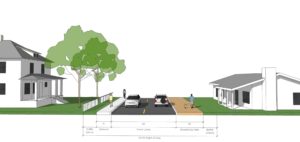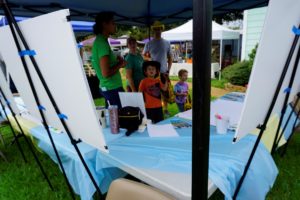Old Seabrook Livable Center Study Wins Gold
The American Planning Association – Houston, Texas Section has recognized the Old Seabrook Livable Center Study with a Gold Medal for Urban Design in the section’s inaugural competition. This is the second APA award for Seabrook, and the project has advanced to the state-level competition for 2022.

The Old Seabrook District is the traditional center and local destination for goods and services, civic functions, and entertainment in the heart of the City of Seabrook. The District has access to Clear Creek and Galveston Bay and features boutique retail and local eateries.
Although its preeminence as a commercial center has diminished as businesses have relocated to SH 146 and NASA Road 1 over the past several decades, those who call Old Seabrook home appreciate the coastal atmosphere, small-town charm, and eclectic character of the area.
The study area encompasses about 55 acres, located north and south of Main Street and east of SH 146. The study area is bounded by SH 146 to the west and Clear Lake to the southeast. With its mix of uses and traditional street grid surrounded by a modestly resurgent residential neighborhood, the area provides a footprint well-scaled for a walkable, mixed-use area. The section of Main Street within the study area has a length of three-quarters of a mile, a scale that further reinforces walkability and civic gathering.
This Livable Center Study aims to leverage the 2035 Comprehensive Masterplan and other previous planning efforts, evaluate the market realities, and present practical recommendations to improve connectivity, encourage economic development, and enhance overall quality of life in the Old Seabrook District.
The study is part of the Houston-Galveston Area Council’s Livable Centers Program, which works with local communities to encourage walkable, mixed-use development, provide opportunities for multi-modal transportation options, improve environmental quality, and promote economic development.
A Livable Center focuses on recommending context-sensitive solutions to create places where people can live, work, and play with less reliance on their cars. The recommendations of this Study aim to both further the goals of the Livable Center Program and achieve the unique vision for Old Seabrook.

Originality, Excellence, and Innovation
This planning process involves four main project phases, each is essential to ensure the final plan reflects the vision of the community, has public support, and includes actionable recommendations.
Public outreach conducted during the first phase of the plan identifies the needs and desires of the community. A combination of engagement methods, including online surveys, community meetings, advisory committee meetings, and outreach at public events, were used for a comprehensive engagement approach. Although the public outreach is identified in the initial phase, participation opportunities were present throughout the process.
Phase two is understanding the area’s existing conditions and market realities is essential to identify the realistic opportunities available in the Old Seabrook District. The physical conditions analysis included a review of existing land uses, building framework, and pedestrian network. A market assessment was also conducted to reveal the types of development that can be supported.

Phase three the Masterplan concepts and recommendations were drafted utilizing the information gathered from the public outreach and needs assessment phases. Recommendations, action items, and economic development strategies accompany the projects in the Masterplan to achieve the area’s vision.
In the final phase, the draft concepts and recommendations of the plan are presented to the community to verify that the vision established in the public outreach phase is reflected in the Masterplan. With support from the community, the plan was then reviewed and adopted by City Council.
As the projects are completed, enhancements can be layered upon previous improvements and built as funds become available. Some projects maybe dependent upon other items in the schedule to be implemented, publicly driven projects can be implemented all at once or evolve. Private-sector projects related to new development and redevelopment should be incentivized proactively and implemented as opportunities arise.
Compatibility

The 2035 Comprehensive Masterplan, adopted in August 2016, describes the intent and character of the Old Seabrook District as an area with small-scale mixed residential, shops, restaurants, and entertainment. The Comprehensive plan also portrays a unique place with local, non-chain establishments that is walkable and pedestrian friendly. The community feedback garnered during the engagement phase in this Livable Center Study Masterplan continues to reflect the same vision for Old Seabrook District as it did in the 2016 Comprehensive Plan.
This Masterplan makes several recommendations related to transportation and connectivity, image, branding and marketing, and future land uses. Both public- and private-driven projects in the Masterplan help guide future development.
There were key considerations from the public and stakeholder input and the existing conditions analysis:

- Maintain the existing small-town character and eclectic appearance
- Improve pedestrian and bicycle connectivity
- Provide more entertainment and family-friendly destinations
- Enhance and capitalize on the waterfront as a community amenity and destination location
- Encourage a mix of uses and development types
These considerations mirror what the community voiced during the comprehensive planning process. These considerations helped guide the planning team through the development of the Masterplan. The public and stakeholder input reveals several key takeaways that represent the ultimate desires of the community. These themes are high-level, over-arching ideas that are repeated throughout the feedback. These concepts will be used throughout the plan to inform the Masterplan and recommendations. The following are the key takeaways from the public input.

Effectiveness and Results
The recommendations in the masterplan describe the actions necessary to bring the elements in the Masterplan to reality. Each recommendation is related to Transportation and Connectivity; Image, Branding, and Marketing; or Future Land Use. Each recommendation includes associated action items, anticipated timeframe for implementation, leading organization, and potential partnerships. City staff should review these recommendations every year to measure their success and determine available funding for implementation.
Each recommendation is intended to achieve one or more elements of the Masterplan. Each recommendation includes several individual action items to implement as part of the recommendation. In many cases, a recommendation may catalyze subsequent recommendations. Action items should be completed as opportunities arise or funding sources become available to support implementation.

Potential partnerships with other organizations are an effective way to achieve a recommendation. Potential partnerships have been identified where coordination with certain departments or teaming up with outside organizations can positively impact the implementation of the recommendation.
Some recommendations may involve activities that set the stage for later recommendations or require prerequisite activities prior to implementation. Recommendations can take place during an earlier or later timeframe depending on changing circumstances or when opportunities become available.

To date, the District has been able to implement several of the recommendations. While the Wastewater Treatment Plant posed a challenge in its existing state, plant removal and improvement of the site represent an opportunity for the District to create an open space for park use. The rehabilitation of the waterfront has already begun with a kayak launch ready for use.
Focusing on priorities will help create better, more cohesive project recommendations that will set up Old Seabrook for more success in the short-term future and create a good foundation for further future enhancement.
Engagement
The key to a successful plan is public engagement and community buy-in. Incorporating the public in the planning process creates a transparent process and ensures the vision for Old Seabrook reflects the community’s vision. The input gathered from residents and stakeholders during these engagement opportunities directly influences the recommendations.
The Stakeholder Advisory Committee (SAC) includes residents, business owners, and community members who are knowledgeable about the history and have an interest in Old Seabrook. The role SAC is to serve as advocates for the plan and to guide plan recommendations.
The planning team met with public and private agencies that have an interest in the development of Old Seabrook. These entities were consulted to ensure the plan’s recommendations align with other initiatives in the area and to identify partnership opportunities.
The planning team met with City Council, Planning and Zoning Commission, and Economic Development Corporation, school district, General Land Office, and Texas Department of Transportation throughout the planning process to gather input from each group about the future of Old Seabrook and provide updates.
A project website was available where the public could learn about the project, review project materials, and submit feedback throughout the process. An online survey was used to ask questions regarding existing conditions in the area and the vision for what Old Seabrook should look like in the future.
Various community meetings/outreach events were held to allow the public to learn about the project and provide feedback on the plan. Outreach events included online community meetings, annual Easter Extravaganza, Jenuine Treasures Market Days, input boards distributed to various businesses within the study area, and public hearings. The purpose of these events was to provide opportunities for the public to participate in the planning process and provide feedback about the plan recommendations.



